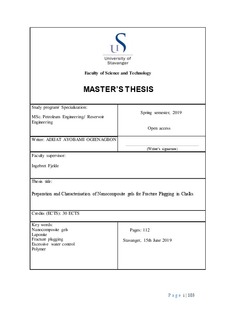| dc.contributor.advisor | Fjelde, Ingebret | |
| dc.contributor.author | Ogienagbon, Adijat | |
| dc.date.accessioned | 2019-10-02T08:47:15Z | |
| dc.date.available | 2019-10-02T08:47:15Z | |
| dc.date.issued | 2019-06 | |
| dc.identifier.uri | http://hdl.handle.net/11250/2619799 | |
| dc.description | Master's thesis in petroleum Engineering | nb_NO |
| dc.description.abstract | Excessive water production is a common challenge the oil industry is faced with. The lifting, treatment and disposal of produced water can cause a financial strain on the profitability of a hydrocarbon asset or even shorten the productive life of the asset. These effects are even more severe in fractured reservoirs as they mature. Among the chemical techniques used for controlling excessive water production, nanocomposite gels (NC) are considered as an effective treatment method. The presence of Nano-clay/polymer network in their structure makes them exhibit stronger fracture plugging potential compared to conventional polymer gel treatments.
In this contribution, laponite and bentonite NC gels were prepared in deionized and seawater. Their performance was characterised and described. The effect of cations like calcium, and potassium, and also the effect of chalk on laponite dispersions were examined. The performance of various low molecular weight glycols like butyl glycol, butyl diglycol and Polyethylene glycol (PEG) employed as gelation retarders on laponite dispersions were also examined. Finally, core flooding tests were carried out to examine and compare the potential of NC gels as a fracture plugging agent in chalk to laponite gels.
The results showed that laponite generally formed better NC gels than bentonite. Laponite clay also dispersed to form weak to highly viscous NC gels with polymers in deionized water depending on its concentration. The presence of cations helped to screen electro-static repulsion between laponite particles resulting in less aging time and stronger laponite gels. PEG can retard laponite gelation reaction, by adsorbing on the clay surface (steric repulsion) resulting in longer aging time to allow the injection of nanocomposite into target zones before its transformation to a rigid gel. Both NC and laponite gels showed potential for plugging fractures and reducing the permeability of water in chalk. However, NC gels showed higher
resistance residual factor compared to laponite gels. It is proposed that further work should be done to confirm the performance of nanocomposite gels as an effective fracture plugging agent in chalks and also their superiority to laponite gels. | nb_NO |
| dc.language.iso | eng | nb_NO |
| dc.publisher | University of Stavanger, Norway | nb_NO |
| dc.relation.ispartofseries | Masteroppgave/UIS-TN-IER/2019; | |
| dc.subject | petroleumsteknologi | nb_NO |
| dc.subject | reservoir engineering | nb_NO |
| dc.subject | reservoarteknologi | nb_NO |
| dc.subject | petroleum technology | nb_NO |
| dc.subject | nanocomposite gels | nb_NO |
| dc.subject | fracture plugging | nb_NO |
| dc.subject | polymers | nb_NO |
| dc.subject | excessive water control | nb_NO |
| dc.subject | laponite | nb_NO |
| dc.title | Preparation and characterization of Nanocomposite gels for fracture plugging in chalks | nb_NO |
| dc.type | Master thesis | nb_NO |
